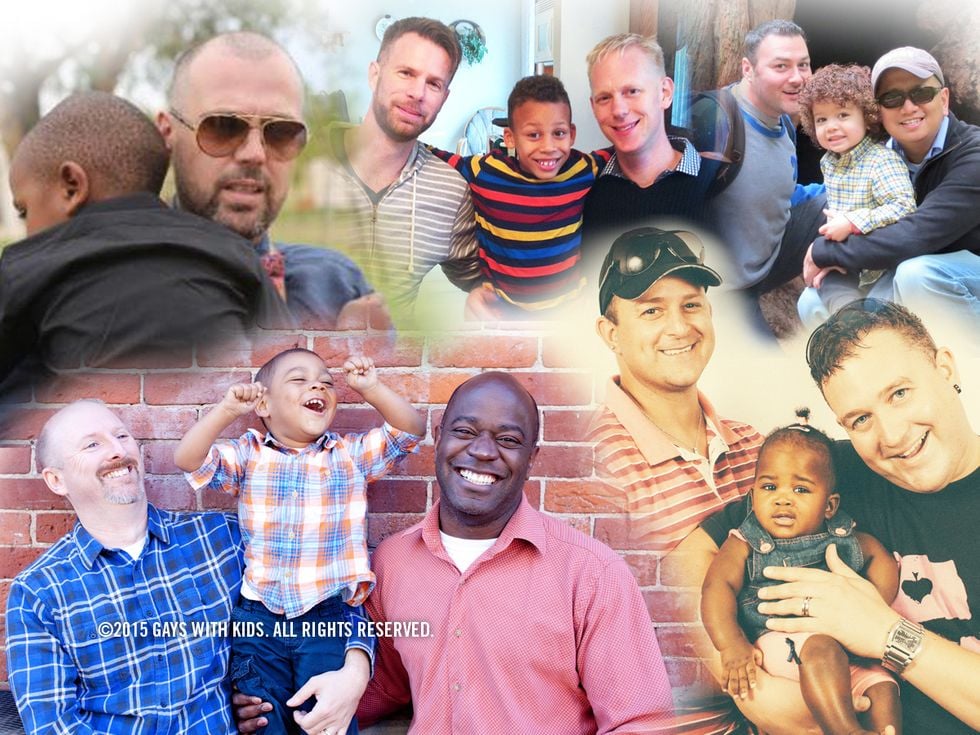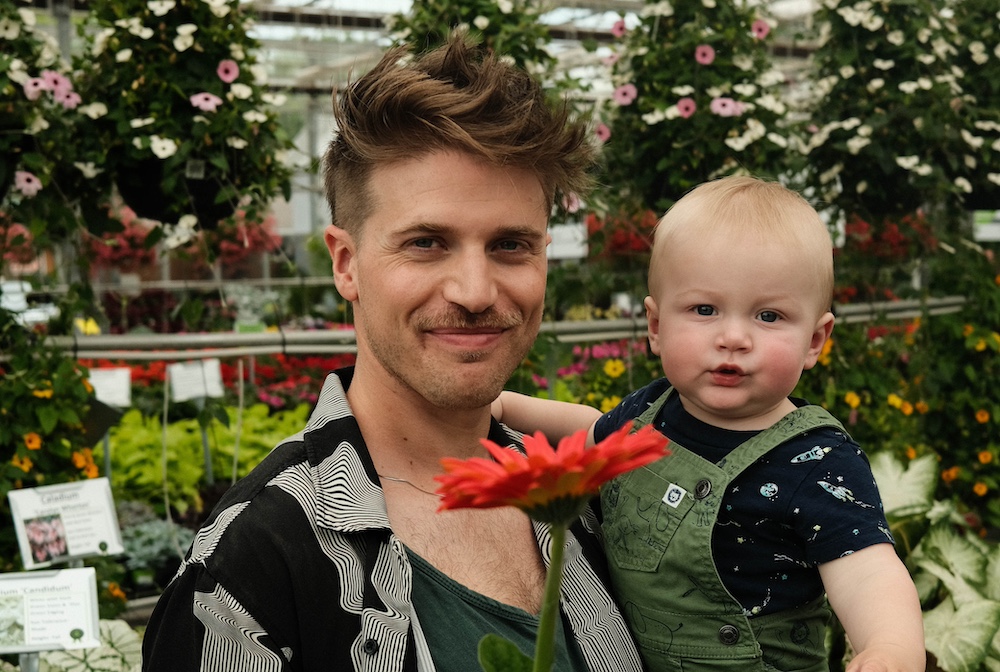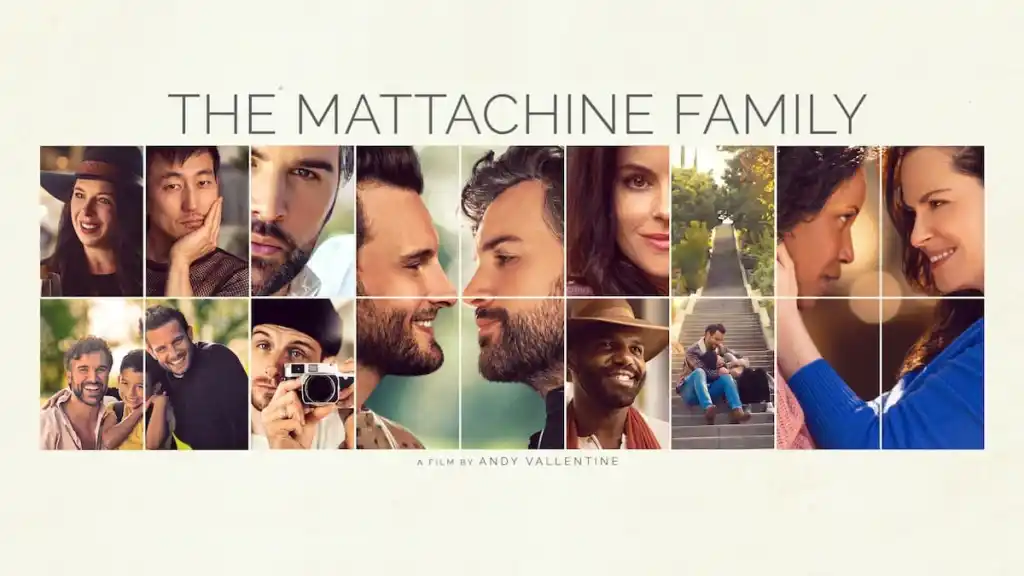You can’t hand a child a crayon box, then ask her to be color-blind.
Nor should you, of course. As the vibrant hues of the Pride rainbow flag remind us: Our community is built on celebrating diversity, not shying away from it. Many gay dads in transracial families (families that consist of parents and children of different races) assume that their children will grow up to be “color-blind”: somehow oblivious to different skin tones. But they soon discover that’s not possible. It’s not even advisable.
If you’re blind, how can you see beauty?
“He was about 4 or 5, and he’d be drawing our family with crayons,” explains Chris Thangaraj, a gay dad from Chicago, of the first time he noticed his eldest son, Noah, acknowledge the family’s transracial identity. Chris is of South Asian descent, and his sons are African-American; Chris’s husband is Caucasian. “When he would draw us, he’d reach for the brown crayon. For my husband, he’d reach for peach or yellow.”
It’s a scenario that was described to us by several parents in transracial families: Crayon selection, evidently, is a pretty common first sign of kids acknowledging racial difference. And for Chris Thangaraj and his husband, Noah’s wordless observation opened a door for important discussions. “It gave us a chance to talk about different skin tones,” says Thangaraj. Their conversations have continued, at age-appropriate levels, ever since.
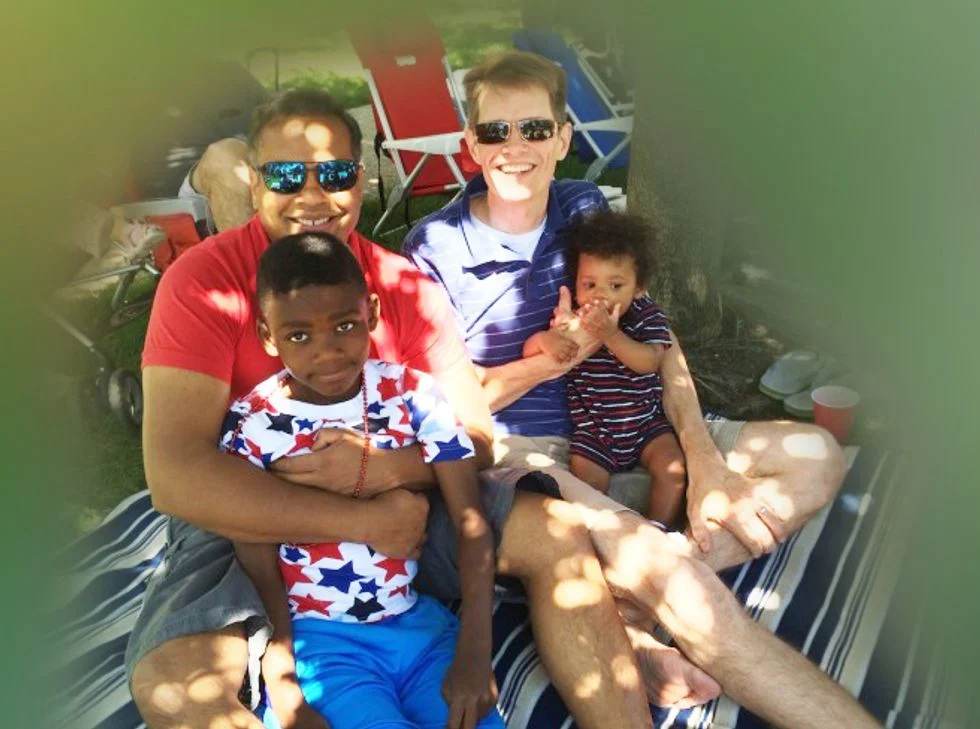
But in case you haven’t noticed, conversations about race are everywhere lately. In particular, headline-grabbing news stories are spawning serious, sometimes contentious discussions about race-related issues. Ferguson, Mo., has become a cultural case study in relationships – often fraught with fear, anger, and distrust – between communities of color and police forces. The shooting deaths of unarmed black teens such as Trayvon Martin and Michael Brown by white police officers have forced conversations about racial profiling of young black men. (Most recently, a Cleveland police officer shot and killed 12-year-old Tamir Rice when he was playing in a park with a toy gun. When he called in the shooting, the officer described the baby-faced boy as “maybe 20.”) Pop culture brings its own set of controversies, like the latest feud between rappers Iggy Azalea (she’s white) and Azealia Banks (she’s black) over hip hop music and cultural appropriation. And Starbucks even seized the zeitgeist as a marketing move. In March it launched a campaign, #RaceTogether, that encourages baristas to write the hashtag on coffee cups to instigate discussions about race. (The idea also instigated some snarky social media backlash.)
For parents in transracial families, those who deal with the nuances of race on a daily basis, these larger discussions feel overdue. But they’re still not easy to have.
“I was shocked and sad,” says Doug Kerr from Toronto, recalling an angry conversation about Ferguson that played out in a Facebook group for gay fathers. For Kerr, who is white, the discussion was profoundly personal: His husband and son are black, and he worries about raising his son in a world where he is more likely to be judged (including by gun-toting law enforcement) by the color of his skin. Kerr says he was alarmed by the vitriol and prejudice the online discussion revealed from other gay white dads. And when the heated conversation reached a boiling point, he was banned from the Facebook group.
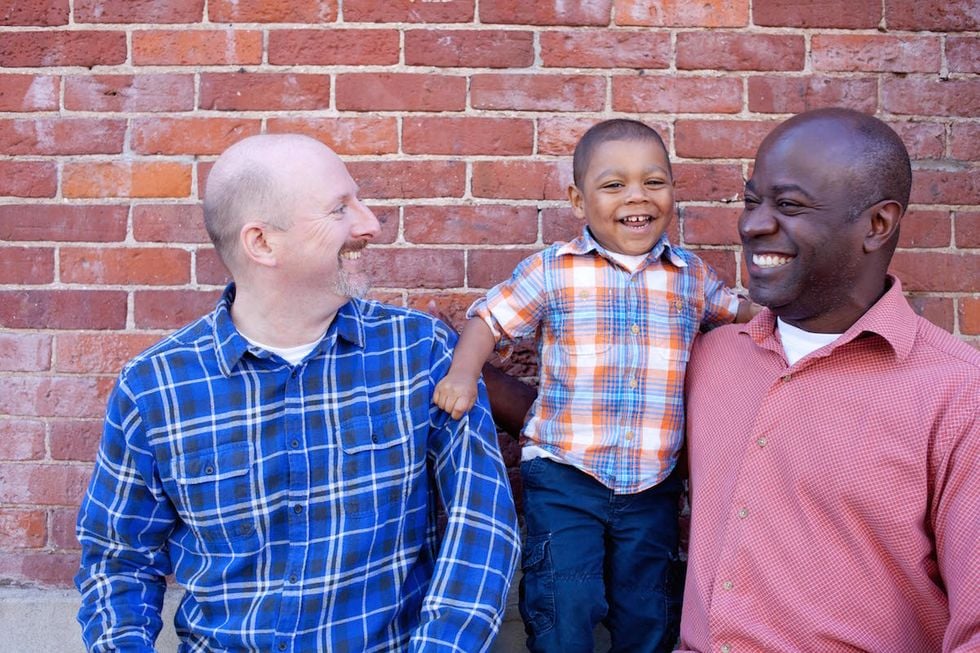

Maybe it’s not relevant, if your kids are white. But for transracial families, it’s a different story, says Doug: Conversations about race are conversations about your child’s health and safety. Doug Kerr was eventually invited to re-join the group, but declined. “I’m not going to be part of a group enforcing white privilege,” he explains. Kerr has since joined a group for transracial families, many of which happen to be headed by same-sex parents, where the conversations are more productive.
These conversations can’t be ignored by gay dads, especially when same-sex couples are more likely than their heterosexual counterparts to choose a transracial adoption in the first place. According to a 2009 study published in Adoption Quarterly by researchers at the University of Virginia, same-sex couples are significantly more likely than opposite-sex couples to complete a transracial adoption, namely 54 percent versus 30 percent. In part, suggest the researchers, that’s because same-sex couples were more likely than opposite-sex couples to be in interracial relationships.
These numbers jive with an informal survey Gays With Kids conducted among transracial families. In our results, about half of respondents “strongly agreed” or “somewhat agreed” that having a transracial family was a deliberate choice. Dads’ reasons ranged: from wanting a family that reflected their interracial relationship, to expectations that the adoption process might move faster.
That last point is worth considering, says Frank Ligtvoet, a white Brooklyn-based gay adoptive co-father of two African-American children. (Ligtvoet writes frequently on adoption issues in the Huffington Post and elsewhere, particularly on transracial and international adoptions; he is also the founder of Adoptive Families With Children of African Heritage and Their Friends.) He bristles at how many white parents adopt children of color for ease and expediency, yet fail to consider the underlying issue: Why can’t these children be cared for by their birth parents?
“It’s a very sad thing to give up your child,” says Frank Ligtvoet. “You have to ask yourself, ‘What were the circumstances? What are the social issues behind adoption? When people so often adopt transracially from poor communities, what does that say about the world we live in?’” To feel you are rescuing a child of color from impoverished circumstances, and analyze no deeper, is a self-congratulatory savior experience, says Frank. True concern should recognize the historic, race-based economic and social inequalities that result in larger populations of prospective adoptees in the first place.
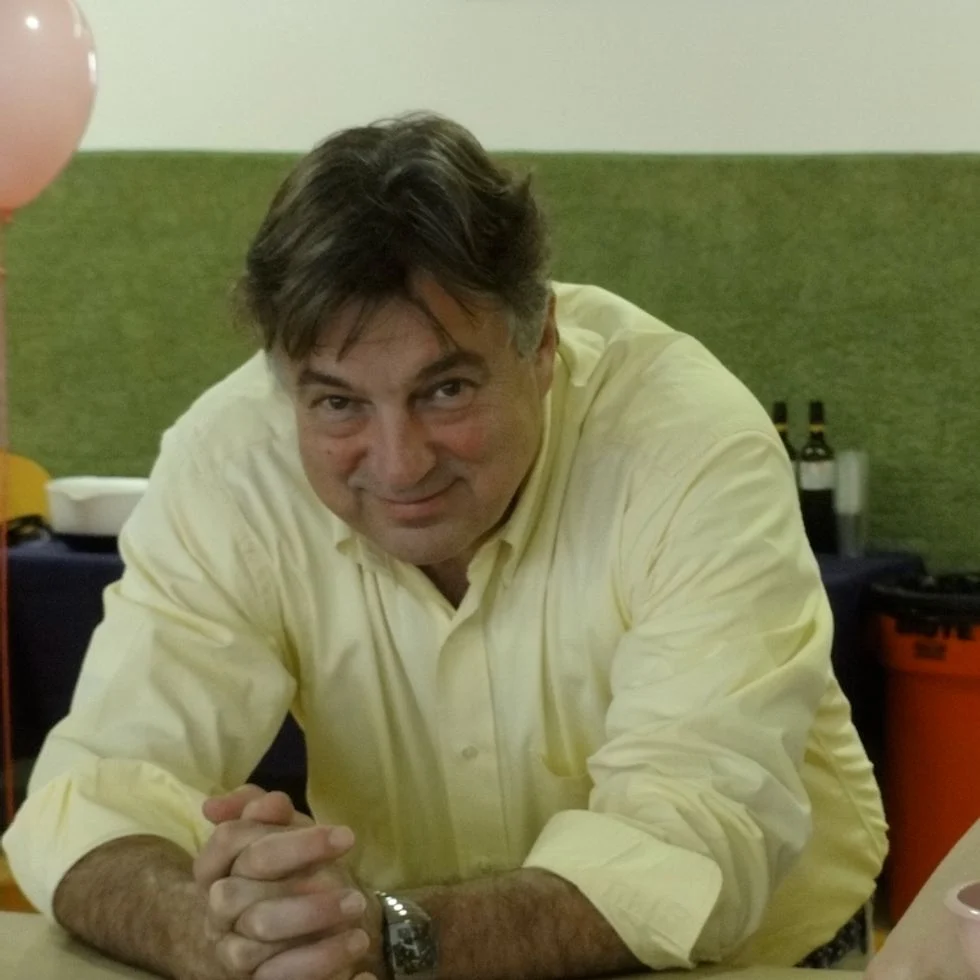

In short, we need to recognize racism. And dare to talk about it.
Yet in our survey of Gays With Kids readers, only half of gay dads in transracial families “somewhat agreed” or “strongly agreed” that “being transracial is an important issue for our family.”
“We don’t make a big deal out of the race of our kids,” remarked one Gays With Kids survey respondent. “My husband’s family is Irish. My parents were Portuguese and German. We don’t address that either.”
It might be time to take off the rose-tinted (or rather, “color-blind”) glasses, says Johnny Cole, a gay dad and educator from Massachusetts. Cole is Asian and his husband is white; together they raise a Latino son and black daughter. He also teaches graduate-level courses that help school districts foster inclusive classrooms, and has led lectures and webinars about issues affecting transracial families for organizations such as the Family Equality Council. Cole says it’s important to acknowledge racial differences within families for a simple reason: They exist. And just as it does a disservice to a child to ignore her unique experience with gay parents in a heteronormative society, it’s unfair to gloss over distinctions between races that inevitably will become part of that child’s reality. (To that previous commenter we’d note: Unlike black, Latino, or Asian backgrounds, various European heritages aren’t immediately distinguishable by others; more important, they are not associated with deep-rooted stereotypes that can cause serious harm.)


“At a certain point a child will hit the encounter stage, when they realize that they can be treated differently [due to race],” explains Cole. The encounter stage is one of five stages identified by Dr. William E. Cross, Jr., a leading theorist and researcher in the fields of clinical psychology and ethnic studies, in his model illustrating the development of racial identity in people of color. The encounter stage might be experienced in childhood or adolescence, says Cole. But when it arrives, it invariably leads to a multitude of emotions – from anger to distrust to sadness – that a parent should help his child navigate to ensure he or she develops confidence, a positive self-image, and pride in racial identity.
For parents in transracial families, it’s only a matter of time before they encounter experiences that will force discussions of race. That’s because not all prejudices are blatant or even intentional, but often it’s their quiet pervasiveness that makes them dangerous. Cole recalls when his daughter was just 3 years old, and a white fellow preschooler remarked that her skin looked “like the color of poop.” Christopher Thangaraj describes how his son Noah intervened in a playground fight to play peacemaker – only to be assumed as the aggressor by a teacher who, perhaps, inadvertently revealed preconceived notions she had about the behavior of young black boys. (The two white kids who started the fight exonerated Noah. Maybe it’s a good thing that the scolding teacher wasn’t a trigger-happy police officer.) And Frank Ligtvoet remembers when his daughter was asked to play an early American colonist in a grade school’s “colonial fair,” a figure who not only would have been white, but also most likely a slave owner. “There was no way I could allow that,” says Frank. “She can’t play a white person in colonial times when she’s a descendant of slaves. It’s demeaning. You have to be an activist and stand up for your child.”
Some dads struggle to do that because they are afraid that acknowledging racial differences will somehow make them feel more profound, and create division instead of conversation.
“I teach my son about only one race: human,” wrote one reader who “strongly disagreed” with the statement “being transracial is an important issue for our family.” That kind of sentiment is, without doubt, well intentioned. But it’s not necessarily the best approach, say gay dads like Mark Hagland of Chicago, who speaks often about transracial adoption at events like the annual KAAN Conference, the Korean American Adoptee Adoptive Family Network Conference. Hagland was born in South Korea, but raised in a largely white community in Milwaukee, Wis., by Norwegian-American and German-American parents. Though Hagland’s parents were certainly loving, they never had conversations wit him about race, he says. And treating it as a taboo topic hardly helps when a child is constantly being confronted with a sense of otherness; in fact, it can reinforce a rejection of their very racial identity. “At school we’d be teased and taunted. If your parents were immigrants from the country you were born in, maybe you’d come home and they’d speak Korean; maybe you’d eat rice or kimchi. We’d come home and eat Swedish meatballs.”
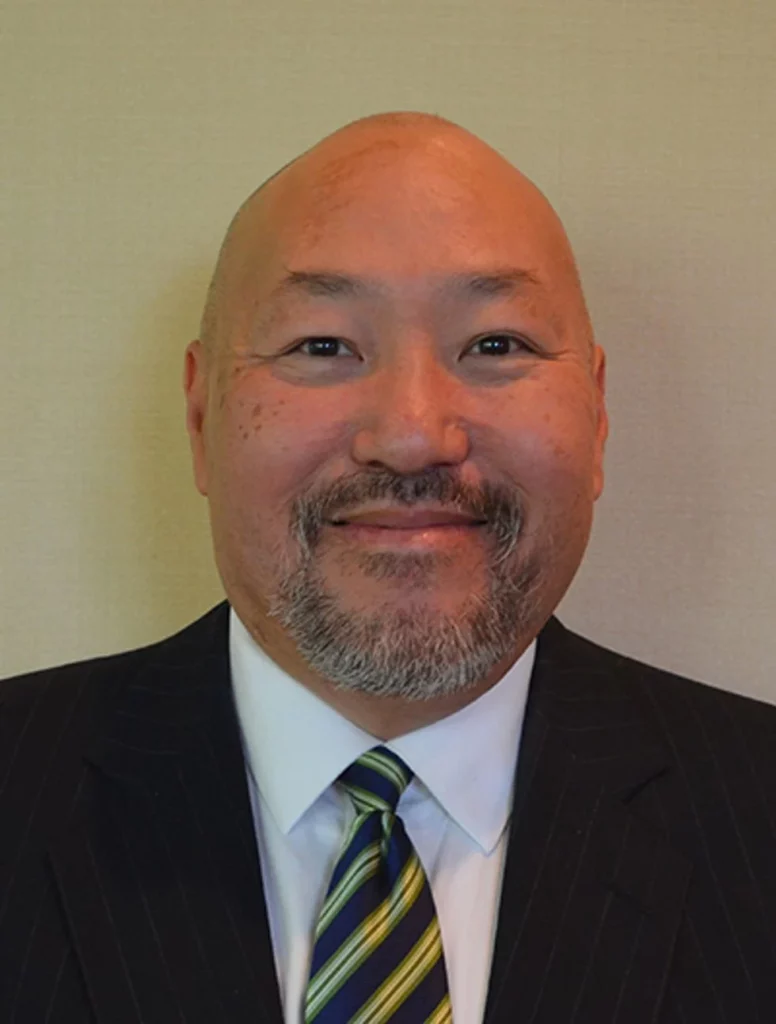

“I spent my entire childhood rejecting my Asian-ness, because the only messaging I got was that not being white was bad.”
In time, of course, that changes. “In many ways, my journey in life as a transracial adoptee is very similar to my journey in life as a gay man,” explains Hagland. “It’s a similar journey of self-discovery and self-unfolding that requires a lot of strength.”
Hagland’s point is well taken. At the same time, the discriminations faced by gay people and people of color are hardly perfect parallels. Yet in our survey, nearly 70% of respondents “somewhat agreed or “strongly agreed” with the statement “being gay or bisexual equips me to help my child deal with race-based discrimination.”
Not so fast, says Johnny Cole. White LGBT parents may encounter certain forms of discrimination, but should avoid equating experiences with homophobia to the race-based prejudices their children of color may endure. “I tell parents, [homophobia] is the point of entry to conversation and a source of empathy, but it’s not the same,” says Cole. (Even without competing in Oppression Olympics, one can certainly recognize fundamental differences: For one thing, it’s not possible to conceal race in the same way one can hide one’s sexuality.) And besides, being gay doesn’t inoculate one from unconscious isms; the LGBT community can be just as discriminatory as any demographic. (Ever feel left out at the bar because you weren’t a young, white, fit, upper middle class urbanite? There you have it.)
Gay fathers in transracial families that we spoke to pay close attention to issues surrounding race, and take certain considerations to ensure that their children of different races have access to resources that will help them develop pride in identity: from culturally comprehensive educations to role models – such as, say, a family pediatrician – of their own race.
Most important, they keep conversations about racial politics going. They know that the solution isn’t to be “color-blind,” but to see the world, in all its color, more clearly.

